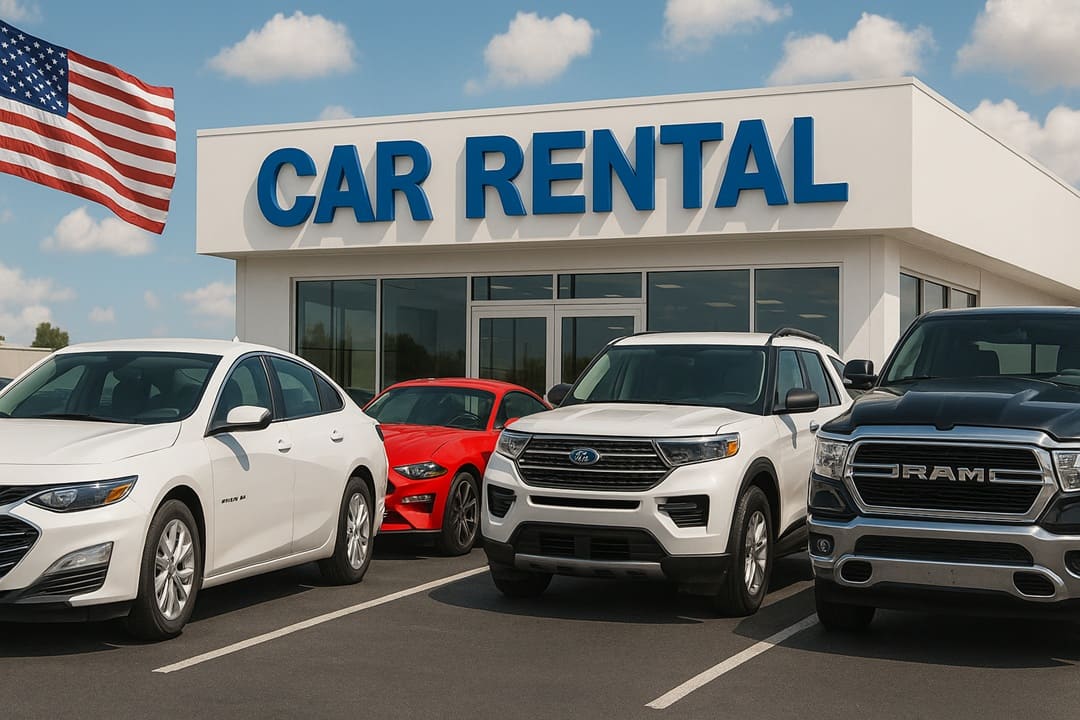A New Era for the Car Rental Industry
The global car rental industry has seen more transformation in the past five years than in the previous two decades. What used to be a traditional service largely centered around airport counters and printed contracts has evolved into a multi-billion-dollar mobility ecosystem. In 2025, renting a car is less about necessity and more about flexibility, sustainability, and digital convenience.
As international travel roared back post-COVID, both business and leisure travelers have embraced car rental as a smart and flexible way to move across cities and countries. But that doesn’t mean the industry simply bounced back to its old ways. The new reality is defined by fleet electrification, app-based rentals, contactless pick-up, and pricing models that mirror ride-sharing platforms.
At the same time, the rise of short-term rentals through mobile-first services like Getaround or Turo has blurred the lines between traditional car rental and car sharing. While classic brands like Hertz and Enterprise still lead in scale and recognition, they now compete in a space where speed, personalization, and digital UX are as important as having thousands of vehicles.
Beyond the traveler, car rental is also becoming an option for locals—city dwellers who don’t want the hassle of owning a car but still need one occasionally. This shift is particularly noticeable in cities like Berlin, Los Angeles, and Barcelona, where mobility-as-a-service is fast becoming the default.
With this new context in mind, the industry’s top players aren’t just companies with the biggest fleets anymore. They’re businesses that manage value across digital infrastructure, vehicle lifecycle, pricing optimization, and customer retention. Let’s take a closer look at who’s winning in 2025—and how.
Who’s Dominating the Market in 2025
In terms of market value, Enterprise Holdings still sits comfortably at the top, though the landscape beneath it is shifting fast. As of early 2025, Enterprise commands a valuation that reflects its wide-ranging operations under the Enterprise Rent-A-Car, Alamo, and National brands. With a presence in over 90 countries and a fleet estimated at more than two million vehicles, the company maintains dominance not just through size, but through its consistent focus on customer service and fleet renewal.
Hertz Global Holdings, after navigating through a high-profile bankruptcy and restructuring earlier in the decade, has repositioned itself with an aggressive push toward electric vehicles (EVs) and subscription-based rentals. Their recent focus on Tesla models and flexible rental durations has attracted a younger, more tech-savvy customer base. Though Hertz trails behind Enterprise in fleet size, its valuation continues to climb due to strong investor confidence and global rebranding efforts.
On the European side, Europcar Mobility Group and Sixt remain the biggest names in the EU market. Europcar’s acquisition by the Volkswagen Group helped expand its reach and modernize its fleet, aligning more closely with the automaker’s broader mobility vision. With a footprint across major airports and city centers from Paris to Prague, Europcar’s network gives it an operational edge in both business and vacation travel segments.
Sixt, meanwhile, has become a standout not just in Germany but also in the U.S. market. With bold orange branding and an app-first experience, the company has combined luxury car rentals with a no-nonsense digital interface. Sixt’s market valuation has seen steady growth, in part thanks to its focus on premium vehicles, seamless booking tech, and transparent pricing structures—something American travelers, in particular, have come to appreciate.
But it’s not just the giants shaping this industry anymore. Up-and-coming players like Getaround in North America, Getmancar in Central and Eastern Europe, and GoCar in Southeast Asia are gaining attention. These regional services are disrupting legacy models with dynamic pricing, flexible access, and hyper-local strategies. In 2025, it’s entirely possible to see someone rent a car in Berlin using Enterprise for a week-long road trip, while another customer books a Getmancar ride in Kyiv for a few hours on the fly—all through an app, all within seconds.
Enterprise Holdings: Still on Top in America
In the United States, Enterprise Holdings remains the undisputed titan of car rental. Headquartered in St. Louis, Missouri, this privately held company has built an empire that spans coast to coast, with tens of thousands of locations operating under three brands: Enterprise Rent-A-Car, National Car Rental, and Alamo Rent A Car. Together, they form a network so dense that in many U.S. cities, it’s hard to walk more than a few blocks without spotting one of their cars.
Enterprise’s fleet in the U.S. is estimated at well over 1.2 million vehicles in 2025, making it not just the largest in the country, but one of the most diversified. From fuel-efficient sedans and SUVs to cargo vans and luxury models, their offering is tailored to everyone from cross-country tourists to local businesses.
But what truly keeps Enterprise ahead isn’t just size—it’s strategy. They’ve doubled down on long-term rentals for local residents, especially in suburban areas where car ownership has declined. They’ve also invested heavily in insurance replacement rentals—the cars people need when their own vehicle is in the shop after a collision. It’s a side of the rental industry most travelers don’t see, but it accounts for a huge chunk of Enterprise’s domestic revenue.
In recent years, Enterprise has taken a cautious approach to electrification. Unlike Hertz, which went all-in with Tesla, Enterprise has opted for a diversified EV rollout that includes models from GM, Ford, and Hyundai. The company has prioritized reliability over flash, and that’s resonated well with older and business-focused clientele. Their EV rentals are often bundled with home charging kits and extended rental packages—ideal for those testing the waters before buying an EV themselves.
On the digital side, the Enterprise app is solid, if not flashy. What it lacks in slick design, it makes up for in reliability. Many American users report sticking with Enterprise because the booking process feels straightforward and the support is consistent—even during holiday rushes or flight delays.
Hertz: Reinventing the Brand in Real Time
Few companies have lived through such dramatic highs and lows as Hertz. Just five years ago, the brand was facing bankruptcy. In 2025, it’s back—and not just back, but reinvented.

The Hertz fleet in the U.S. is now over 650,000 vehicles, and what makes it stand out is the aggressive shift toward electric. After announcing a bold plan to buy over 100,000 Teslas in 2021, Hertz doubled down in the years that followed by adding Polestar, Kia, and GM electric models. Today, nearly 35% of their fleet is electric, making them one of the greenest major rental companies in the country.
The company’s push toward tech-first mobility has reshaped its customer base. Hertz is no longer just a go-to at the airport—it’s a brand that appeals to digital nomads, eco-conscious millennials, and corporate travelers who want performance and sustainability in one sleek package. Their mobile app experience is smoother than ever, with features like real-time vehicle upgrades, keyless entry, and on-the-fly extensions, all baked into a single interface.
But it’s not just the cars that are changing. Hertz has invested in subscription models and flexible monthly rentals that challenge the very definition of “rental.” For example, a user can rent a Tesla Model 3 for an entire month, with service, insurance, and roadside assistance included—no lease, no long-term contract. For Americans frustrated with traditional car ownership, this is a compelling new path.
Yet, Hertz’s comeback isn’t without its challenges. Supply chain issues, competition from peer-to-peer platforms, and customer complaints about availability still hang in the background. But their bold positioning and high-profile marketing campaigns have succeeded in making Hertz relevant again, especially among younger renters.
Avis Budget Group: Playing the Long Game
Unlike the explosive rebranding efforts of Hertz, Avis Budget Group has taken a more measured route. With two of the most recognizable names in the American rental market—Avis and Budget—this company serves millions of domestic travelers annually, particularly those looking for mid-tier to economy rentals.
Avis has long been a staple at U.S. airports, and in 2025, it continues to dominate that space. Whether you’re landing in Orlando, Denver, or LAX, you’re likely to see a long row of Budget and Avis vehicles waiting outside the terminal. Their strength lies in scale and fleet reliability, not necessarily innovation—but that’s starting to shift.
The group has recently announced investments in EV infrastructure and has begun to experiment with connected car services, including real-time fuel tracking and dynamic pricing. Budget, in particular, has seen success with value-seeking domestic renters, including weekend getaways, family vacations, and short-term insurance replacements.
One area where Avis Budget shines is corporate partnerships. In 2025, the company has expanded deals with American Express, Delta, and major hotel chains to offer bundled travel packages and loyalty points. It’s a quieter form of expansion, but one that steadily builds brand stickiness among business travelers and frequent flyers.
Still, their mobile experience trails behind competitors like Hertz and Sixt, and their customer service reviews are more mixed. But their market share in the U.S. remains solid, and in smaller cities across the Midwest and South, Avis and Budget are often the only national rental brands with full-service offices.
The Rise of Digital-First Rentals and Car Sharing Hybrids
While traditional brands continue to dominate, there’s been a noticeable shift in how Americans rent cars in 2025. Services like Turo and Getaround are no longer just side gigs—they’re full-blown platforms with millions of users, offering an Airbnb-style experience for vehicles.
In places like Austin, San Diego, and Miami, younger travelers are more likely to book a Tesla through Turo than stand in line at a rental counter. These platforms offer more freedom, flexible pricing, and a peer-to-peer connection that appeals to Gen Z and millennials. The ability to filter by make and model, choose local hosts, and skip the desk entirely has changed what people expect when they think of “renting a car.”
Some traditional rental companies have responded by launching their own digital arms. Avis has Zipcar, Enterprise is experimenting with Enterprise Flex-E, and Hertz is integrating more peer-to-peer style tools into its platform. But there’s still a gap in UX and trust: the tech-native platforms are moving faster.
Fleet Size as a Power Metric in the U.S. Market

When it comes to renting a car, most customers don’t think about fleet size—they just want a clean vehicle that’s ready to go. But behind the scenes, fleet size is one of the most important indicators of strength and reliability in the American car rental market.
Companies like Enterprise and Hertz don’t just operate large fleets—they manage highly strategic inventories that are tailored to match local demand. In Orlando, Florida, you’ll find minivans and SUVs for families heading to Disney. In downtown Chicago, compact cars and hybrids dominate the lot. The ability to anticipate what people want to drive in a specific city—and have those vehicles available in real time—is what keeps customers loyal.
As of 2025, Enterprise’s U.S. fleet exceeds 1.2 million vehicles, while Hertz manages around 650,000 domestically. Avis and Budget together account for nearly 500,000 cars and vans in the U.S. alone. But it’s not just the numbers—it’s how those vehicles are distributed, maintained, and upgraded.
Fleet rotation cycles have also become faster. In the past, rental companies would hold on to vehicles for 2–3 years. Now, many are cycling out cars after just 12–18 months, especially as electric vehicles gain popularity and depreciation rates change. This ensures that renters almost always get a newer model, which translates to better fuel economy, cleaner interiors, and more up-to-date tech features like CarPlay, Android Auto, and driver assist.
There’s also the question of vehicle diversity. Fleet size isn’t just about scale—it’s about variety. A strong car rental company in 2025 offers everything from full-size pickups and EVs to luxury sedans and cargo vans. As more customers look to rent vehicles for very specific purposes—moving across town, testing an EV, taking a road trip with pets—this level of fleet flexibility becomes a competitive edge.
Market Value in Motion: The Business Behind the Wheel
In 2025, the market value of car rental companies tells a deeper story than just revenue or bookings. It’s a reflection of brand trust, technological adaptability, global partnerships, and investor confidence in the future of mobility.

Enterprise Holdings, as a privately owned company, doesn’t disclose its valuation, but industry estimates put it comfortably above $40 billion in total global value, with a large chunk of that centered in the United States. Its dominant domestic footprint, combined with robust B2B contracts, makes it one of the most stable players in mobility.
Hertz Global Holdings, which is publicly traded again after its dramatic recovery, has seen its valuation climb to around $13–15 billion in early 2025. The stock price is largely driven by its EV initiatives, subscription models, and high visibility in corporate travel. However, investors remain cautious about scalability and customer service gaps.
Avis Budget Group, also publicly listed, trades in the $10–12 billion range. Its slower tech adoption has raised eyebrows among analysts, but its performance remains steady due to strong airport operations and dependable fleet utilization. Recent strategic investments in connected car tech could tip the scale in its favor if executed well.
Then there are the tech-native disruptors. Platforms like Turo, which went public in late 2024, currently trade at a valuation close to $6 billion, with Getaround not far behind. While their fleets are peer-owned and smaller by volume, the platforms themselves are seen as lean, scalable tech plays in a traditional industry.
Valuation is no longer just about the size of the company—it’s about agility, platform strategy, and fleet monetization. Can a company turn vehicles into assets that generate revenue faster, last longer, and offer better margins? That’s the question every investor is asking in 2025.
Technology and Mobility Trends Reshaping the Industry
Perhaps the most dramatic change in the American car rental market over the past five years has been the integration of smart mobility technology into everyday operations. From mobile booking to keyless entry and real-time car location tracking, the act of renting a car in 2025 looks nothing like it did in 2015.
For one, contactless rental is no longer a luxury—it’s the norm. Major brands like Enterprise and Hertz have overhauled their platforms to allow users to select a vehicle, unlock it, and drive away without ever talking to a human. This became essential during the pandemic, but its convenience and efficiency have made it a permanent fixture.
There’s also been an explosion in dynamic pricing algorithms, similar to what airlines and ride-sharing companies use. Rental prices now shift depending on location, demand, fuel prices, and even local events. This has given tech-savvy users an advantage—but it’s also pushed companies to improve their mobile app UX, making it easier for the average traveler to compare options and book on the go.
And then there’s vehicle telemetry. In 2025, most rental cars in the U.S. come equipped with telematics systems that monitor everything from tire pressure to driving habits. While this improves fleet maintenance and reduces breakdowns, it’s also opening up new pricing models, like usage-based rentals and even rewards for safe driving.
Lastly, EV infrastructure is expanding. Airports, hotels, and rental offices are now equipped with fast chargers, and renters are increasingly choosing electric not just for environmental reasons, but for the cost savings and smooth driving experience. The ability to rent a Mustang Mach-E for a long weekend or try out a Chevy Bolt for a month is turning EVs into mainstream rental choices.

Regional Powerhouses Worth Watching
While the big names dominate national headlines, regional car rental players are quietly reshaping how Americans and travelers abroad think about renting a car. These companies may not have the market share of Enterprise or the tech buzz of Turo, but their hyper-focused strategies and local relevance are pushing the industry forward in unexpected ways.
Take Getmancar, for instance—a company that started in Eastern Europe but is gradually building a presence in the West. While it’s primarily known for its urban car sharing model in cities like Kyiv, Chisinau, and Tbilisi, the company has recently expanded into traditional car rental in Germany, including Berlin, Frankfurt, and Munich. Its fleet in these cities includes everything from compact daily drivers to mid-size SUVs, and its pricing structure is transparent and competitive—especially appealing to travelers used to overpaying at the airport.
Getmancar’s model blends the convenience of car sharing (minute-based pricing, smartphone unlocks) with the reliability of classic daily and weekly rentals. This hybrid approach makes it uniquely suited for regions where infrastructure is evolving and users expect flexibility without friction. In Berlin, for example, Getmancar isn’t trying to beat Sixt at luxury—it’s offering affordable, clean, accessible transportation for people who just want to get around the city without commitments.
In the U.S., local and regional rental franchises are also making waves. In college towns like Ann Arbor or Boulder, small independent operators often beat the big chains in both price and customer service. Some have even gone all-electric or built subscription models to appeal to students, freelancers, or new residents who aren’t quite ready to buy a car but need something reliable.
Then there’s Kyte, a San Francisco-based startup that delivers rental cars directly to your door. Their approach strips away the rental counter entirely, positioning the company somewhere between a delivery service and a tech platform. While still limited to select metro areas, Kyte represents a broader shift in what consumers now expect: fewer logistics, more automation, and total convenience.
Even in a globalized industry, local execution still matters. Regional leaders often understand parking laws, insurance quirks, road conditions, and user habits better than the international giants. That’s why these smaller names aren’t just surviving—they’re thriving in the niches the giants overlook.
What’s Next for 2026 and Beyond
Looking ahead, the global car rental industry is entering a period of redefinition rather than disruption. After years of trying to copy the Uber model or compete with ride-sharing, rental companies are now carving out their own lane—one that combines ownership flexibility, electric mobility, and digital experience.
The trend toward subscription-based car access is only going to grow. Whether it’s a three-day road trip or a three-month work assignment, people want options without long-term commitment. This means companies will need to rethink fleet management, pricing, and even customer education.
Electric vehicles will dominate not just in California or Norway, but across North America, Europe, and Asia. Governments are incentivizing adoption, rental companies are investing in charging infrastructure, and users are becoming more comfortable with driving EVs—even in rural areas. The fleet of the future will be cleaner, quieter, and cheaper to operate.
On the tech side, expect rental platforms to get smarter, with AI-powered booking systems, predictive maintenance alerts, and even in-car personalization. You might step into a rental car that already knows your Spotify playlist, preferred temperature, and driving style.
And what about autonomy? Self-driving rentals aren’t here yet, but they’re coming. Several pilot programs are already running in California and Texas, and it’s likely that by 2030, the concept of “driving your rental” will evolve into “being transported by your rental.”
At the same time, regulation and sustainability will play bigger roles. Cities like New York and Paris are tightening restrictions on emissions and congestion, which means rental companies will need to partner with municipalities, offer greener options, and even rethink what “ownership” means in urban mobility ecosystems.
One thing is clear: car rental is no longer just about travel. It’s about lifestyle, choice, and movement on your own terms. Whether you’re renting a car in Berlin through Getmancar, grabbing a Tesla from Hertz at LAX, or having a Kyte vehicle delivered to your doorstep in Seattle, the experience in 2025—and beyond—is increasingly frictionless, tailored, and on your schedule.
| Company | Market Value (2025) | Fleet Size (U.S.) | EV Share | Digital UX Rating | Notes |
|---|---|---|---|---|---|
| Enterprise | ~$40B (estimated) | 1.2M+ vehicles | ~15% | ★★★★☆ | Focus on reliability and local rentals |
| Hertz | ~$14B | ~650K vehicles | ~35% | ★★★★★ | Aggressive EV expansion; strong app UX |
| Avis/Budget | ~$11B | ~500K vehicles | ~10% | ★★★☆☆ | Dominant at airports; slower tech adoption |
| Sixt (U.S. arm) | N/A (global ~$8B) | ~100K vehicles | ~20% | ★★★★☆ | Luxury focus, strong mobile app presence |
| Turo | ~$6B (public) | Peer-to-peer platform | ~25% | ★★★★★ | Airbnb-style experience for vehicles |
| Getmancar (EU) | Private | Limited in U.S. | ~30% | ★★★★☆ | Hybrid model, new in Germany/Europe |
| Kyte | Startup, private | Urban micro-fleet | ~50% | ★★★★★ | Door-to-door delivery, app-first model |
